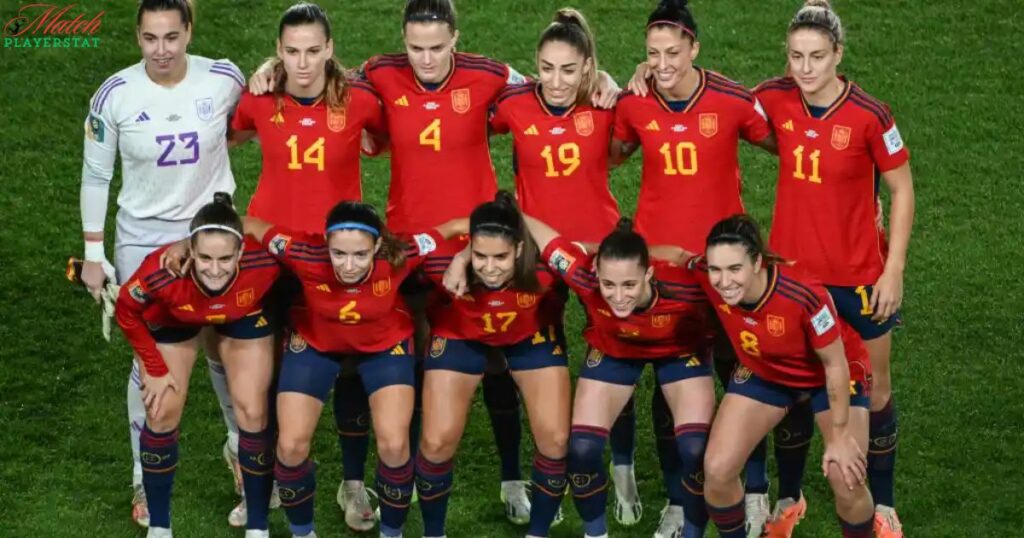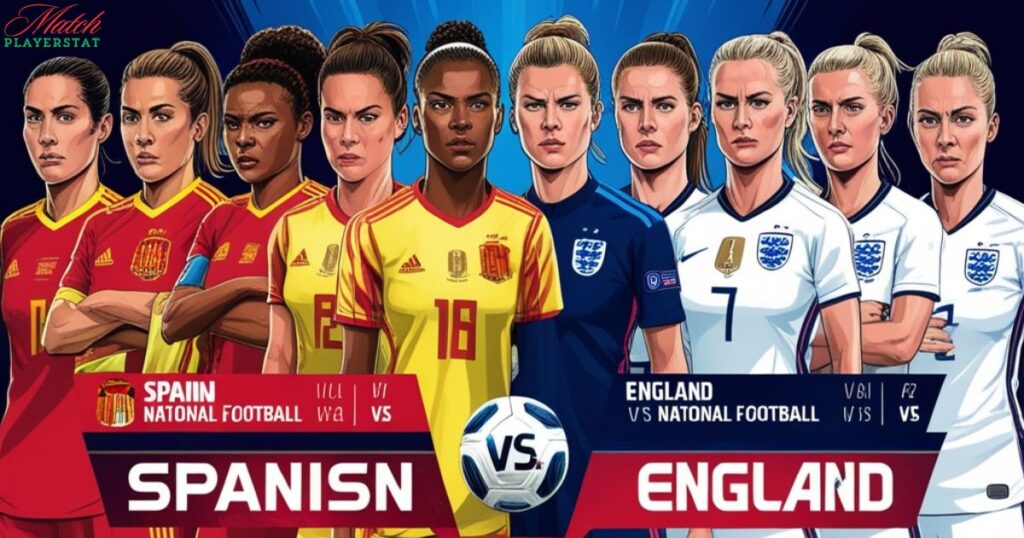On August 20, 2023, the world of women’s football witnessed a historic clash as the Spain Women’s National Football Team faced off against the England Women’s National Football Team in the FIFA Women’s World Cup final.
This article delves deep into the intricate details of the Spain women’s national football team vs England women’s national football team lineups, exploring the tactical nuances, key player performances, and strategic decisions that shaped this monumental match.
Introduction
The 2023 FIFA Women’s World Cup Final marked a watershed moment in the history of women’s football. As the sun rose over the packed stadium, anticipation built for what would prove to be an epic encounter between two footballing powerhouses:
Spain and England. Both teams had navigated a grueling tournament, showcasing skill, determination, and tactical prowess to reach the pinnacle of women’s football, much like the highly anticipated clash between the England women’s national football team vs Australia earlier in the tournament.
The importance of team lineups in determining match outcomes cannot be overstated. As we’ll explore, the carefully crafted formations and player selections by both teams played a crucial role in the ebb and flow of this historic final.
From Spain’s possession-based mastery to England’s resilient defensive structure, every aspect of the lineups contributed to a match that will be remembered for generations.
Spain Women’s National Football Team Lineup

Spain’s approach to the final was embodied in their 4-3-3 formation, a tactical setup that allowed them to dominate possession and control the tempo of the game. Let’s break down their lineup and examine the roles of key players:
Goalkeeper
- Sandra Paños: The last line of defense, Paños brought composure and shot-stopping ability to the Spanish goal.
Defense
- Mapi León and Irene Paredes: A formidable center-back pairing, combining León’s reading of the game with Paredes’ aerial prowess.
- Laia Codina and María León: Dynamic full-backs providing both defensive stability and attacking support.
Midfield
- Aitana Bonmatí: The creative engine, dictating play with vision and technical skill.
- Ingrid Engen: A defensive midfielder focused on ball recovery and disrupting England’s attacks.
- Alexia Putellas: A world-class playmaker, linking midfield and attack with precision.
Forward Line
- Jenni Hermoso: A technically gifted forward with a keen eye for goal.
- Alba Redondo: Known for her tireless work rate and ability to stretch defenses.
- Olga Carmona: The captain and eventual match-winner, combining leadership with attacking prowess.
This lineup offered Spain a perfect blend of creativity, defensive solidity, and attacking threat. The midfield trio of Bonmatí, Engen, and Putellas proved particularly crucial, allowing Spain to dominate possession and control the rhythm of the game.
England Women’s National Football Team Lineup

England, under the guidance of coach Sarina Wiegman, opted for a 4-2-3-1 formation, balancing defensive stability with attacking potential. Here’s a breakdown of their lineup:
Goalkeeper
- Mary Earps: A commanding presence between the posts, known for her shot-stopping and distribution.
Defense
- Millie Bright and Leah Williamson: A solid center-back partnership, combining physical presence with tactical awareness.
- Lucy Bronze and Rachel Daly: Attacking full-backs providing width and support in both defense and attack.
Midfield
- Keira Walsh and Georgia Stanway: A dynamic double pivot, balancing defensive duties with progressive passing.
- Ella Toone: An attacking midfielder tasked with linking play and creating chances.
Attack
- Lauren Hemp and Chloe Kelly: Pacey wingers capable of stretching the Spanish defense.
- Alessia Russo: A physical presence up front, leading the line with her hold-up play and goal-scoring ability.
England’s lineup was designed to absorb pressure and hit Spain on the counter-attack, utilizing the pace of Hemp and Kelly on the wings.
Spain’s Strategy and England’s Response
Spain’s tactical approach centered around their fluid passing game and positional play. The 4-3-3 formation allowed them to dominate possession, with Aitana Bonmatí pulling the strings in midfield. Their strategy involved:
- High pressing to regain possession quickly
- Quick ball circulation to create space
- Utilizing the width provided by full-backs to stretch England’s defense
- Exploiting the creativity of Putellas and Bonmatí to break through England’s lines
England, on the other hand, focused on a more pragmatic approach:
- Maintaining a solid defensive shape
- Using the pace of Hemp and Kelly to counter-attack
- Relying on Walsh and Stanway to disrupt Spain’s midfield play
- Exploiting set-pieces to create scoring opportunities
The clash of these tactical approaches led to a fascinating contest, with Spain’s technical superiority often tested by England’s defensive resilience and counter-attacking threat.
Key Moments and Player Performances
The match was defined by several pivotal moments that showcased the quality of both teams:
- Olga Carmona’s Match-Winning Goal: Spain’s captain delivered when it mattered most, scoring the only goal of the game with a well-placed shot.
- Mary Earps’ Penalty Save: A crucial moment that kept England in the game, demonstrating Earps’ ability to perform under pressure.
- Aitana Bonmatí’s Midfield Masterclass: The Spanish midfielder’s control and creativity were at the heart of Spain’s dominance.
- Millie Bright’s Defensive Heroics: England’s center-back put in a colossal performance, often thwarting Spain’s attacks single-handedly.
These moments underlined the importance of individual brilliance in shaping the outcome of such a high-stakes match.
Tactical Analysis

The tactical battle between Spain and England was a chess match of the highest order. Spain’s 4-3-3 formation allowed them to control the midfield, with Bonmatí, Putellas, and Engen forming a formidable trio. This control translated into prolonged periods of possession, forcing England to defend deep for long stretches.
England’s 4-2-3-1 setup was designed to provide defensive stability while offering quick counter-attacking options. The double pivot of Walsh and Stanway worked tirelessly to break up Spain’s play, while the pace of Hemp and Kelly on the wings provided an outlet for quick transitions.
Key tactical points:
- Spain’s use of wide areas to stretch England’s defense
- England’s compact defensive block to limit space between the lines
- The role of full-backs in both teams’ attacking play
- The importance of set-pieces as a route to goal in a tight match
Key Player Insights
Several players stood out with their performances, shaping the course of the match:
Olga Carmona (Spain)
- Role: Captain and match-winner
- Key Stat: 1 goal, 3 key passes
Aitana Bonmatí (Spain)
- Role: Midfield maestro
- Key Stat: 92% pass accuracy, 2 chances created
Mary Earps (England)
- Role: Goalkeeper and penalty saver
- Key Stat: 5 saves, 1 penalty save
Millie Bright (England)
- Role: Defensive lynchpin
- Key Stat: 8 clearances, 3 blocked shots
These performances underline the impact individual players can have on the biggest stage, even within the context of team tactics.
Impact of the Lineups on the Game
The team lineups and tactical choices, much like in the 49ers vs Kansas City Chiefs match player stats, played a crucial role in shaping the flow and outcome of this game.
Spain’s control over possession and their ability to generate attacking opportunities stemmed from their well-structured midfield and offensive formation. This approach proved successful, as it enabled them to break through England’s defense and score the decisive goal.
On the other hand, England’s formation, while strong on defense, struggled to counter Spain’s midfield control. Despite their solid defense and Mary Earps’ penalty save, England found it difficult to create clear scoring opportunities against Spain’s disciplined backline.
FAQ’s
Who was in England’s starting 11 against Spain?
England’s starting lineup included Mary Earps, Lucy Bronze, Millie Bright, Leah Williamson, Rachel Daly, Keira Walsh, Georgia Stanway, Ella Toone, Lauren Hemp, Chloe Kelly, and Alessia Russo.
Who is in the Spain women’s football squad for 2024?
As of the 2023 World Cup, key players like Sandra Paños, Irene Paredes, Aitana Bonmatí, and Jenni Hermoso are expected to feature in the 2024 squad, though official announcements are pending.
What trophies have the England women’s football team won?
The England women’s team won the UEFA Women’s Euro 2022, their first major international trophy.
Where can I watch the Spain National Football Team vs England National Football Team?
Major international matches are typically broadcast on national sports channels and streaming platforms. Check your local listings for specific details on future matches.
Conclusion
The 2023 FIFA Women’s World Cup Final between Spain and England was a tactical masterclass, showcasing the evolution of women’s football at the highest level. Spain’s victory, secured by Olga Carmona’s decisive goal, was a testament to their technical prowess and strategic acumen. England, despite falling short, demonstrated the resilience and tactical flexibility that had brought them to the final.
This match will be remembered not just for its outcome, but for the quality of football on display. It highlighted the importance of thoughtful lineup selection, tactical adaptability, and individual brilliance in determining the outcome of high-stakes encounters.
As we look to the future, both Spain and England have set a new benchmark for women’s football, inspiring the next generation of players and tacticians alike. The impact of this historic match will resonate for years to come, shaping the development of the women’s game worldwide.
Welcome to Tech Trendery! This blog is your go-to source for the latest in technology trends. Whether you’re a tech enthusiast or just curious, you will find something interesting here. Let’s dive into the world of Tech Trendery.

Hello, I’m Dan Brown, a writer at Matchplayerstat. I explore the dynamic world of players and celebrities, delivering captivating insights and updates. Join me on Matchplayerstat.com for the latest in player stats and celebrity news.”
